Medicinal Plants Part 1
Jone Tiffany, Anoka County Extension Master Gardener
Plants have been used in herbal medicine for centuries to enhance health, treat illnesses, and support the body’s natural healing abilities. Herbal medicine involves utilizing various plant parts such as leaves, roots, flowers, seeds, and bark for their therapeutic benefits. These plant materials contain active compounds that contribute to their medicinal effects.
Herbal medicine emphasizes a holistic approach, aiming to restore balance in the body rather than just treating symptoms. While generally considered gentle and natural, herbs can interact with medications or cause side effects, so seeking professional guidance is important. As scientific validation and public interest grow, herbal medicine continues to play a role in both traditional and integrative healthcare systems worldwide.
In this article, Medicinal Plants Part I, I will discuss two plants: chamomile and echinacea. Chamomile (Matricaria chamomilla) is one of the most widely used medicinal herbs worldwide. With a long history in traditional medicine, chamomile is known for its calming properties and is commonly consumed as herbal tea. Its flowers contain compounds that contribute to its therapeutic effects. One of chamomile’s uses is as a natural remedy for anxiety and insomnia. Chamomile binds to receptors in the brain, exerting a mild sedative and anti-anxiety effect without the risks associated with pharmaceutical drugs. Drinking chamomile tea before bed can help improve sleep quality. Chamomile is also used to support digestive health. It has antispasmodic properties, making it effective in relieving indigestion, gas, and nausea. In addition to calming nerves and the digestive system, chamomile possesses anti-inflammatory and antimicrobial properties. These make it effective in treating minor wounds, skin irritations, and infections. When applied topically, chamomile creams help reduce redness, itching, and inflammation while promoting skin healing. Chamomile is generally safe and well-tolerated; however, it should be used with caution by individuals allergic to plants such as ragweed or daisies. It may also interact with blood thinners, so individuals on anticoagulant medications should consult a healthcare provider before using chamomile regularly.
Purple coneflower, (Echinacea purpurea) has become a recognized herbal remedy for supporting immune health. The roots, leaves, and flowers of the plant are used medicinally, most often in the form of teas, tinctures, or capsules. One of the most popular uses of Echinacea is in the prevention and treatment of upper respiratory tract infections. Research suggests that Echinacea stimulates the immune system by increasing the activity of white blood cells and may reduce the severity and duration of cold symptoms. Echinacea is useful for fighting infections and for enhancing the body’s resistance to disease. It is sometimes used as a preventive remedy during cold and flu season. Beyond respiratory infections, Echinacea possesses anti-inflammatory properties. Topically, Echinacea has been used to treat burns, insect bites, and skin infections. Its wound-healing properties support tissue regeneration and may reduce the risk of infection. Echinacea-based creams and ointments are also used to manage eczema and acne due to their soothing effects. While generally considered safe for short-term use, long-term continuous use is not typically recommended, as its effects could potentially overstimulate the immune system or reduce effectiveness over time.
Chamomile
Echinacea (Coneflower)


